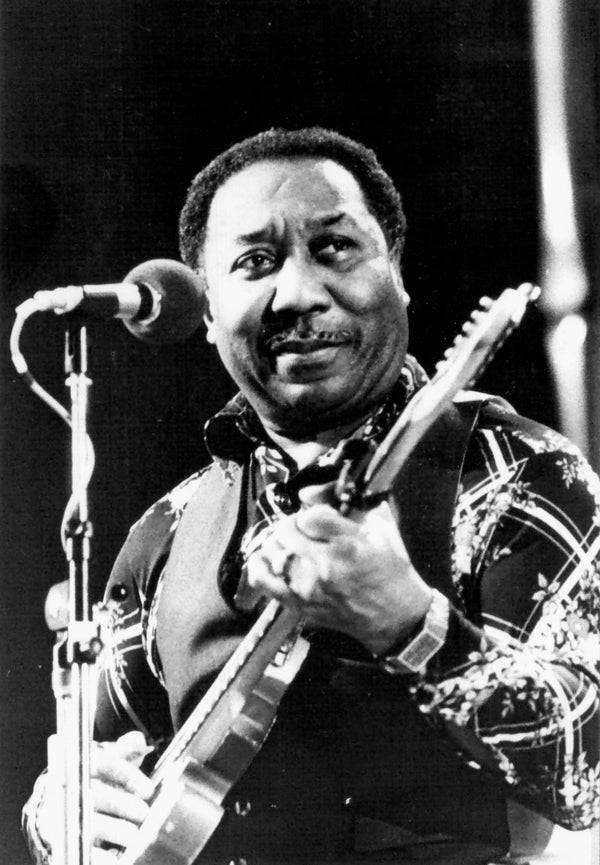Where do you start, when considering the great Muddy Waters? A True Giant of post-war American music, an incredible and enduring influence on successive generations of musicians, composer of several of the classic songs of the Blues, musical touchstones that stand inviolate in the rock and roll pantheon. The innovator who turned the Blues electric, and in so doing galvanised and inspired thousands of others to pick up the musical baton and shape it their own way.
Muddy was born McKinley Morganfield in April 1913 in Issaquena County, Mississippi, growing up on Stovall Plantation, near Clarksdale, Mississippi. By the age of seventeen, he was playing guitar and harmonica, following on from the likes of Robert Johnson and Son House. He made the journey north to Chicago in 1943, the classic route followed by scores of his contemporaries, seeking work in the industrial mid West foundries and car factories, but Waters wanted to become a professional musician, even though he had to make ends meet by driving a truck or working in a factory whilst playing Chicago clubs at night.
He was recorded as early as 1941, by the legendary Alan Lomax for the Library of Congress, and in 1946 cut his first records, firstly for Columbia, and then for the fledgling Aristocrat label, set up by brothers Leonard and Phil Chess. His original recordings for the Chess brothers were basic, just his voice and guitar and maybe a stand-up bass and second guitar, but as he moved into the 1950s, playing in rowdy clubs opening for the likes of Big Bill Broonzy, he realised that, if he actually wanted to make himself heard, he would have to get himself an electric guitar and an amplifier. He assembled a band of awesome musical firepower, with the likes of Little Walter Jacobs on harmonica, Jimmy Rogers on guitar, Otis Spann on piano, and bass and drums (several musicians moving in and out of these seats). It was the finest, best-drilled blues band of its generation.
Muddy and his band were invited to Carnegie Hall in 1959 and the Newport Jazz Festival in 1960. The LP made at Newport, full of his recent hits like ‘Tiger In Your Tank’ and ‘Got My Mojo Working’ influenced many British R&B bands. They set the blueprint for the behemoth that was the British R&B scene of the sixties, spawning the likes of Cyril Davies, The Rolling Stones, The Animals, Manfred Mann, Guy Stevens, The Yardbirds, Alexis Korner, John Mayall, and Peter Green’s Fleetwood Mac.
Moving into the 1960s, the ‘British Invasion’ was in large part, an exercise in ‘selling coals to Newcastle’ – the sound of pimply white British youth trying to mimic middle-aged black American sharecroppers – and in the wake of The Beatles, it was The Rolling Stones who would channel the power and urgency of the Blues and feed it back to American Youth, who, through a combination of racial segregation and the not-so-unofficial ‘colour bar’ of US TV and radio, had been prohibited from hearing the music. The Stones, who actually derived their name from a Muddy Waters song, paid further due homage to their black forebears by recording their ‘Five By Five’ EP during their first American tour, at the Chess studios in 2120 South Michigan Avenue in Chicago in June, 1964.
Although Waters’ fortunes waxed and waned through the late sixties and on into the seventies, and he was badly injured in a car crash in 1970, he was at least able to work regularly and see some financial reward for his songwriting efforts and magisterial musical influence. His career would enter a late-flowering renaissance, firstly as a guest on the bill of The Last Waltz, the final performance by The Band, and shortly afterwards when he hooked up with guitarist Johnny Winter for four fine, critically acclaimed and decent-selling albums for the Blue Sky record label. The first of the four – Hard Again (1977) - was widely regarded as one of Waters’ finest.
Muddy died from heart failure and complications arising from cancer on 30th April 1983. Two years after his death, the city of Chicago paid tribute to Muddy Waters by designating the one-block section between 900 and 1000 East 43rd Street near his former home on the south side "Honorary Muddy Waters Drive". And in 2017 a ten stories-mural commissioned as a part of the Chicago Blues Festival and designed by Brazilian artist Eduardo Kobra was painted on the side of the building at 17 North State Street, at the corner of State and Washington Streets.
With thanks to Alan Robinson

